Somewhere beyond Los Angeles and California’s surf lies the land of red dust and crimson peaks. A place where the earth is molded in the image of quiet cataclysm and HG Wells landscapes.
Lonesome. Desolate. Seemingly hollow.
And yet, underneath the buzz of silence, the earth is humming and thick with life. Confounding, resilient, and hearty life. The kind that lures you in slowly and then swallows you whole before you realize you’ve even passed through its lips.
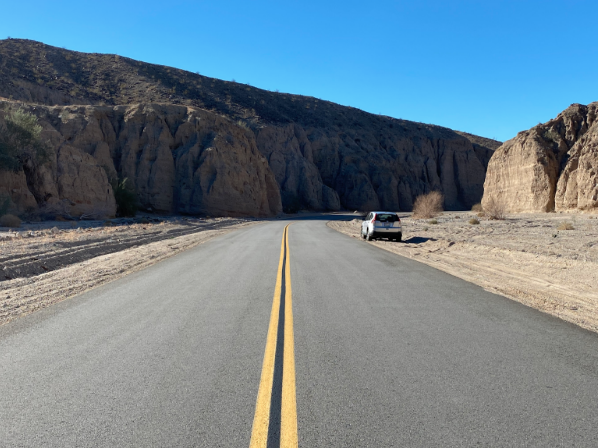
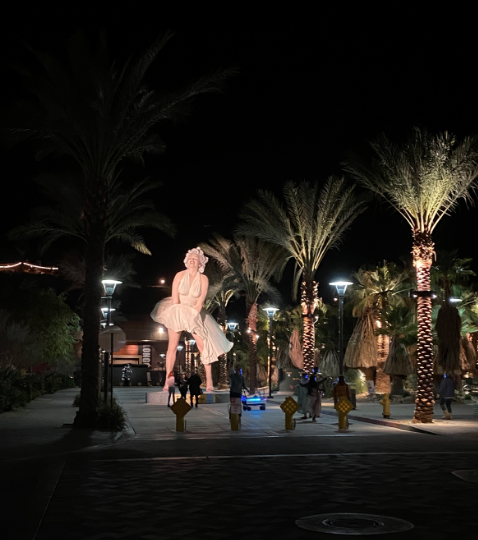
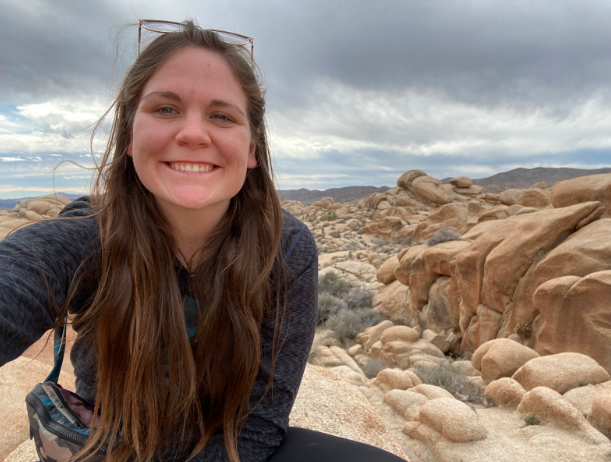
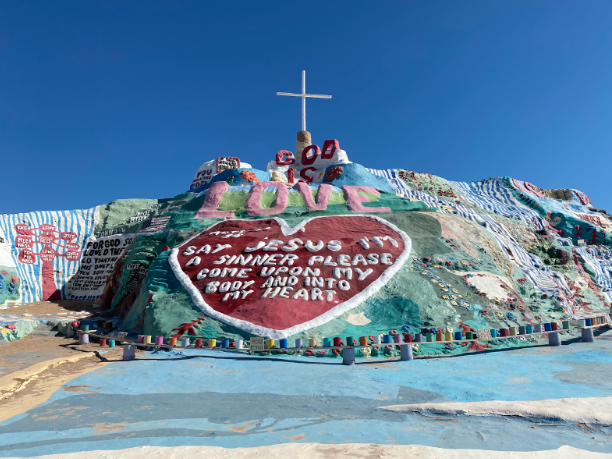
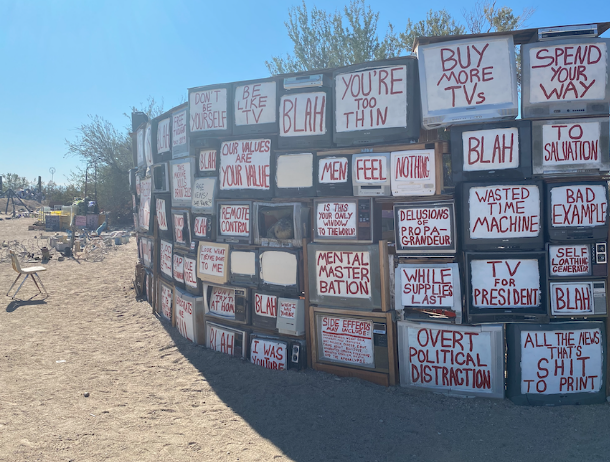
Welcome to Southern California, where the seams of the Mojave, Sonora, Colorado, and Great Basin Deserts come together. It’s a strange place and home to many contradictions – to the posh and the poor, farmland and wasteland, vastness and void.
Cruising the open highway it’s equal parts paradise and apocalypse, where it feels like the world is ending and beginning all at once. Something is enchanting about its vast stretches of highway and wilderness. Even if it’s just for a weekend, the desert’s the perfect place for a road trip out West.
Passing Through Palm Springs
Palm Springs is a playground for the well-to-do and a moment in time. Tucked between the Sonora Desert’s extraterrestrial landscapes, something about it feels temporary, like a fantasy that could only exist in a half-remembered dream, a Salvador Dali painting, or the setting of a Lana del Rey song.
Inevitably, Palm Springs is a place the desert will eventually swallow up, returning all of its old-Hollywood charm and vintage architecture to the dusty ridges of the Coachella Valley. There’s an eeriness that lies under its elegant veneer. Nature feels pitiless. Like you’re at the mercy of the sun’s constant gaze and the whims of the San Andreas fault. Like God is nowhere and everywhere at the same time.
But for now, Palm Springs has plenty to offer in the way of luxury: five-star restaurants, high-end shops, and private hideaways where you can spend an afternoon lounging in Southern California’s sun. It’s not exactly backpacker-friendly, but that’s not to say Palm Springs can’t be done on a budget, especially with such quick access to the desert.
I arrived on a Friday during the high season in January. Night had already fallen by the time I pulled into the BelleVue Oasis – my retro, mid-century modern home base five minutes from the town’s main drag.
It had the vibe of late 60s Hollywood, with a pool deck lined with palm trees and loungers overlooking the desert mountains. Complete with a hot tub that almost always had a vacancy and a clear view of the desert stars, the Bellevue embodies quintessential Palm Springs. It was a perfect base for galavanting through the desert.
Downtown, Palm Springs’ manicured streets were bustling with well-heeled tourists from across the Southwest. Restaurants were packed. Bars bustled with booze-seekers. And its shops gleamed with goodies for the glittery and the glamorous.
Frankly, it’s lovely. Palm Springs offers something for most travelers, and it’s hard not to like. Friday night, I feasted on my Italian favorites at Johnny Costa’s Ristorante. Saturday night, I dipped in and out of stores in the Old Paseo Shopping District, including the Crescent Arts and Crafts, where the clerk gave me a weirdly accurate palm reading before I meandered off for dinner.
And yet, Palm Springs wasn’t where I spent most of my weekend. Maybe I’ll spend my days wining, dining, and unwinding during my next visit. But for this stint, I wanted to explore the weird and the wild of the desert.
A Jaunt into Joshua Tree
Just outside the bounds of Palm Springs’ glitzy golf courses, hip hotels, and bougie boutiques, I set my sights for Joshua Tree National Park, where I stepped into the desert’s strange, other-worldly vastness.
Solitude buzzed in my ears amidst the martian and seemingly empty landscape. As I drove past snow-capped peaks, between deserted canyons, and down miles of lonely highway, I felt the soul of the Coachella Valley waiting to reveal itself, and yet it existed just beyond my grasp.
After getting off the highway, I pulled over to the side of the road 10 minutes from the park’s entrance. It was early in the morning, and there were almost no cars or signs of life. The quiet filled my ears as the lyrics to “Desolation Row” ran through my head.
The desert’s cold in January. And windy. Despite my wool socks and donning my favorite pullover, I was surprised to learn I needed a jacket and maybe a pair of gloves. If you go, I recommend coming with multiple layers, plenty of water, and lots of snacks to be prepared for anything.
The park is vast, spanning 3,218 km² of boulders and rock formations, gardens of cacti, and giant Joshua trees for which it was named. Imagine walking around on Mars, but with some alien-looking vegetation, purple mountains in the distance, and a few winding roads meandering through the landscape. That’s Joshua Tree.
You can certainly do the park’s highlights in a day – that’s what I did during this visit. I got my picture at Skull Rock, lingered through the Cholla Cactus Garden, and drank in the panoramic view of the Coachella Valley from Keys View. I ambled over giant boulders and desert footpaths and red hills for miles.
And yet it wasn’t enough time. One day I want to return to Joshua Tree for at least a few days to experience the desert at night or watch the sunrise over the mountains. To go deeper and soak up the quiet moments and solitude the desert offers.
So when you visit, I recommend spending at least 2-3 days camping or staying in town nearby so you can explore every hidden corner of the park.
A Sunday Stroll through the Slabs
After her relationship ended, Terry packed her apartment in Appalachia and made her way to Slab City – an off-the-grid, alternative community 90 minutes from Palm Springs that residents call the “Last Free Place in America.”
Today, she sells jewelry and nicknacks outside her trailer to tourists visiting the community, which has no services. No water. No electricity. No trash pickup on Tuesday. Occasionally, cops from the adjacent town of Niland make their rounds but otherwise keep away. And that’s how residents like it.
“It’s not lawless here, but it’s pretty close,” said Terry gazing at the desert landscape. “It’s probably as close as you’re going to get.”
“It’s like a mental institution, and the government pretty much stays out of it. You can run down the street screaming, and no one will bat an eye. They might even join you.”
After World War II, Slab City sprung up on the decommissioned Marine Corps Camp Dunlap site. Today, it’s a haven for artists, outlaws, hippies, drug users, and outcasts who want to disappear completely – not unlike the Wild West meets the island of misfit toys.
This town seems absurd on the surface – like it shouldn’t exist. But if you dig deeper, you’ll find a creative and thriving community, a collection of folk art made from piles of rubbish, and the remnants of the pioneering spirit that propelled the American West forward.
In my view, this is one of the few places where people can live fully and authentically on their terms. I found beauty and comfort in that. You can be exactly who you are in the Slabs and no one judges you.
Salvation Mountain greeted me when I pulled in. Leonard Knight’s surrealist, technicolor homage to Christianity rose from the desert like an acid dream, complete with Bible verses, religious proverbs, and dozens of murals stretched across its fifty-foot high, 150-foot wide mountain canvas.
Upon arrival, John from Niland invited me shooting. Later, I shared an ice cream with Pink Gorilla at the Wrangler’s Roost, where a woman named Phyllis explained how she found refuge here after kidnapping her kids from an abusive ex-husband in the 70s.
When everyone had unemployment and stimulus checks during the pandemic, the Wrangler’s Roost was booming. Now that the money’s dried up, Phyllis said business had too.
As I demolished my ice cream cone, Phyllis told me who ran with the thieves and who got chased out with guns. She shared how the Slabs were perfect until “some blabbermouth” posted on Facebook and the tweakers came. After giving me a crash course on who to trust, where to go, and what to avoid, I left the Wrangler’s Roost and headed to East Jesus – an experimental, living sculpture garden made from trash.
Burned out cars. Broken televisions. Rusty bird cages. Shards of glass. The residents of East Jesus use bits and pieces of garbage to create an evocative art collection. Throughout the year, artists come and stay to build and maintain the sculptures, given the desert’s unforgiving nature.
Should you spend a day in East Jesus, there are three rules you should know:
-
You’ll see a row of carpets that look like a path when you walk in. They are a lie. Walk wherever you want. Touch the art. Make music.
-
You can lick whatever you want in East Jesus. But in the event you cut your tongue while licking, all blood will be considered a contribution to the art.
-
If you break something, you need to find someone you don’t know in the park to blame it on.
East Jesus and Slab City embody outlaw culture and are the closest I’ve ever seen to anarchy. They are real and raw and warped and weather-beaten.
And yet somehow – despite the harshness of the desert – there’s a stronger sense of community here than I’ve found in much of the United States. Self-sufficiency, libertarianism, and distrust of society tie everyone together, and the people make it work.
Maybe the Slabbers have lost their way. Or perhaps they’ve found it. Who knows?
Visiting is like seeing your reflection in a funhouse mirror: gnarled and distorted, and yet there you are, staring back. Ultimately, you’ll see whatever you want to see and find what you want to find. The weird, the beautiful, and the surreal are all yours for the taking.
What will the Desert Reveal to You?
There’s a feeling in the desert I can’t capture with words, but I know it will draw me back again and again. It’s eerie, breathtaking, and absurd all at once, where seekers of silence, off-the-grid living, and Instagrammable vacations converge.
In all of its weirdness, I see the desert as a microcosm of life in post-pandemic America, with equal parts squalor and wealth, untold abundance and emptiness. The site of many paradoxes interwoven together, amidst miles of arid and magnificent landscapes that stretch before you for hundreds of miles. And you should totally go check it out.
– This post was written by Meghan Garrity, writer and traveler (and one of Miranda’s very best friends). You can find her and follow her travels on Instagram, @meghanelizabeth222